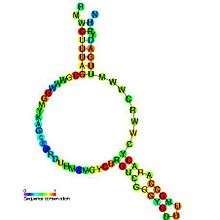Retron
A retron is a distinct DNA sequence found in the genome of many bacteria species that codes for reverse transcriptase and a unique single-stranded DNA/RNA hybrid called multicopy single-stranded DNA (msDNA). Retron msr RNA is the non-coding RNA produced by retron elements and is the immediate precursor to the synthesis of msDNA. The retron msr RNA folds into a characteristic secondary structure that contains a conserved guanosine residue at the end of a stem loop. Synthesis of DNA by the retron-encoded reverse transcriptase (RT) results in a DNA/RNA chimera which is composed of small single-stranded DNA linked to small single-stranded RNA. The RNA strand is joined to the 5′ end of the DNA chain via a 2′–5′ phosphodiester linkage that occurs from the 2′ position of the conserved internal guanosine residue.

| Retron msr RNA | |
|---|---|
 Predicted secondary structure and sequence conservation of msr | |
| Identifiers | |
| Symbol | msr |
| Rfam | RF00170 |
| Other data | |
| RNA type | Gene |
| Domain(s) | Bacteria |
| SO | 0000233 |
| PDB structures | PDBe |
Retron elements are about 2 kb long. They contain a single operon controlling the synthesis of an RNA transcript carrying three loci, msr, msd, and ret, that are involved in msDNA synthesis. The DNA portion of msDNA is encoded by the msd gene, the RNA portion is encoded by the msr gene, while the product of the ret gene is a reverse transcriptase similar to the RTs produced by retroviruses and other types of retroelements.[1] Like other reverse transcriptases, the retron RT contains seven regions of conserved amino acids (labeled 1–7 in the figure), including a highly conserved tyr-ala-asp-asp (YADD) sequence associated with the catalytic core. The ret gene product is responsible for processing the msd/msr portion of the RNA transcript into msDNA.
For many years after their discovery in animal viruses, reverse transcriptase was believed to be absent from prokaryotes. Currently, however, RT-encoding elements, i.e. retroelements, have been found in a wide variety of different bacteria. Retrons were the first family of retroelement discovered in bacteria; the other two families of known bacterial retroelements are group II introns and diversity-generating retroelements (DGRs).[2] Group II introns are the best characterized bacterial retroelement and the only type known to exhibit autonomous mobility; they consist of an RT encoded within a catalytic, self-splicing RNA structure. Group II intron mobility is mediated by a ribonucleoprotein comprising an intron lariat bound to two intron-coded proteins. The second family of bacterial retroelement, DGRs, are not mobile, but function to diversify DNA sequences.[3] For example, DGRs mediate the switch between pathogenic and free-living phases of Bordetella.[4]
Since retrons are not mobile, their appearance in diverse bacterial species is not a "selfish DNA" phenomenon. Rather, retrons must confer some selective advantage to the host organism. What this advantage may be is unknown. Except for producing msDNA, no clear phenotype has been associated with them. Despite considerable investigation, very little is known about the function of msDNA, the mobility of retron elements, or their effect on the host cell.[5][6]
References
- Lampson BC, Inouye M, Inouye S (2005). "Retrons, msDNA, and the bacterial genome" (PDF). Cytogenet Genome Res. 110 (1–4): 491–499. doi:10.1159/000084982. PMID 16093702.
- Simon DM, Zimmerly S (2008). "A diversity of uncharacterized reverse transcriptases in bacteria". Nucleic Acids Res. 36 (22): 7219–7229. CiteSeerX 10.1.1.358.8390. doi:10.1093/nar/gkn867. PMC 2602772. PMID 19004871.
- Medhekar B, Mille JF (2007). "Diversity-Generating Retroelements". Current Opinion in Microbiology. 10 (4): 388–395. doi:10.1016/j.mib.2007.06.004. PMC 2703298. PMID 17703991.
- Liu M, Gingery M, Doulatov SR, Liu Y, Hodes A, Baker S, Davis P, Simmonds M, Churcher C, Mungall K, Quail MA, Preston A, Harvill ET, Maskell DJ, Eiserling FA, Parkhill J, Miller JF (2004). "Genomic and Genetic Analysis of Bordetella Bacteriophages Encoding Reverse Transcriptase-Mediated Tropism-Switching Cassettes". J. Bacteriol. 186 (5): 1503–1517. doi:10.1128/JB.186.5.1503-1517.2004. PMC 344406. PMID 14973019.
- Ahmed, AM; Shimamoto T (2003). "msDNA-St85, a multicopy single-stranded DNA isolated from Salmonella enterica serovar Typhimurium LT2 with the genomic analysis of its retron". FEMS Microbiol Lett. 224 (2): 291–297. doi:10.1016/S0378-1097(03)00450-6. PMID 12892895.
- Lampson, BC; Xu C; Rice SA; Inouye S (2002). "A partial copy of msDNA from a new retron element is likely a retrotransposed DNA found in the myxobacterium Nannocystis exedens". Gene. 299 (1–2): 251–261. doi:10.1016/S0378-1119(02)00977-0. PMID 12459273.